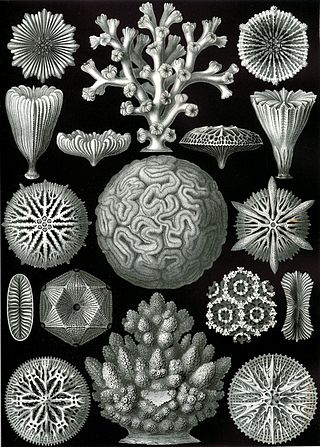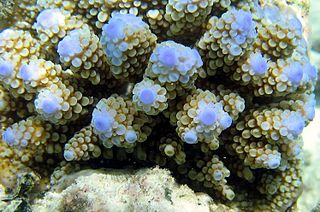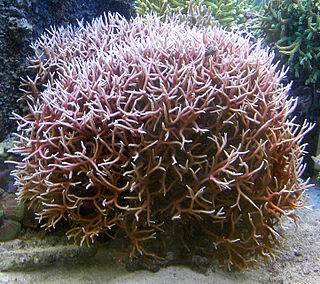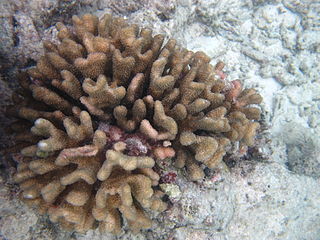
Anthozoa is a class of marine invertebrates which includes the sea anemones, stony corals and soft corals. Adult anthozoans are almost all attached to the seabed, while their larvae can disperse as part of the plankton. The basic unit of the adult is the polyp; this consists of a cylindrical column topped by a disc with a central mouth surrounded by tentacles. Sea anemones are mostly solitary, but the majority of corals are colonial, being formed by the budding of new polyps from an original, founding individual. Colonies are strengthened by calcium carbonate and other materials and take various massive, plate-like, bushy or leafy forms.

The crown-of-thorns starfish, Acanthaster planci, is a large starfish that preys upon hard, or stony, coral polyps (Scleractinia). The crown-of-thorns starfish receives its name from venomous thorn-like spines that cover its upper surface, resembling the biblical crown of thorns. It is one of the largest starfish in the world.

Scleractinia, also called stony corals or hard corals, are marine animals in the phylum Cnidaria that build themselves a hard skeleton. The individual animals are known as polyps and have a cylindrical body crowned by an oral disc in which a mouth is fringed with tentacles. Although some species are solitary, most are colonial. The founding polyp settles and starts to secrete calcium carbonate to protect its soft body. Solitary corals can be as much as 25 cm (10 in) across but in colonial species the polyps are usually only a few millimetres in diameter. These polyps reproduce asexually by budding, but remain attached to each other, forming a multi-polyp colony of clones with a common skeleton, which may be up to several metres in diameter or height according to species.

Pocillopora is a genus of stony corals in the family Pocilloporidae occurring in the Pacific and Indian Oceans. They are commonly called cauliflower corals and brush corals.

The Pocilloporidae are a family of stony corals in the order Scleractinia occurring in the Pacific and Indian Oceans.

Hymenocera picta, commonly known as the harlequin shrimp, is a species of saltwater shrimp found at coral reefs in the tropical Indian and Pacific Oceans. It is usually considered the only species in the genus Hymenocera, but some split it into two species: H. picta from the central and east Pacific, where the spots are deep pinkish-purple with a yellow edge, and H. elegans from the Indian Ocean and west Pacific, where the spots are more brownish and have a blue edge. They reach about 5 cm (2.0 in) in length, live in pairs, and feed exclusively on starfish, including crown-of-thorns starfish. They do seem to prefer smaller, more sedentary starfish, but as these generally are not sufficiently numerous for their needs, they commonly attack crown-of-thorns starfish, both reducing its consumption of coral while under attack, and killing it within a few days.

Montipora capitata, commonly known as rice coral or pore coral, is a stony coral in the family Acroporidae. It is a reef building species and is found in tropical parts of the Pacific Ocean.

Stylophora pistillata, commonly known as hood coral or smooth cauliflower coral, is a species of stony coral in the family Pocilloporidae. It is native to the Indo-Pacific region and is commonly used in scientific investigations.

Trapezia rufopunctata is a species of guard crabs in the family Trapeziidae.

Acropora cytherea is a stony coral which forms horizontal table like structures. It occurs in the Indo-Pacific Ocean in areas with little wave action, favouring back reef environments from 3 to 20 m depth.

Acropora aspera is a species of staghorn coral in the family Acroporidae. It is found on reef flats and in lagoons in very shallow water in the western Indo-Pacific Ocean.

Pocillopora damicornis, commonly known as the cauliflower coral or lace coral, is a species of stony coral in the family Pocilloporidae. It is native to tropical and subtropical parts of the Indian and Pacific Oceans.

Pocillopora verrucosa, commonly known as cauliflower coral, rasp coral, or knob-horned coral, is a species of stony coral in the family Pocilloporidae. It is native to tropical and subtropical parts of the Indian and Pacific Oceans.

Acropora nasuta is a species of branching stony coral in the family Acroporidae. It is native to the western and central Indo-Pacific where it is found in shallow reef habitats. Like other corals of the genus Acropora, it is susceptible to coral bleaching and coral diseases and the IUCN has listed it as being "Near Threatened".

Anomastraea is a monotypic genus of corals in the family Coscinaraeidae. It is represented by a single species, the crisp pillow coral.

Pocillopora grandis, is a colonial species of stony coral in the family Pocilloporidae. It is known commonly as antler coral, and is found in the Indo-West Pacific to the Eastern Tropical Pacific.

Seriatopora hystrix is a species of colonial stony coral in the family Pocilloporidae. It forms a branching clump and is commonly known as thin birdsnest coral. It grows in shallow water on fore-reef slopes or in sheltered lagoons, the type locality being the Red Sea. It is native to East Africa, the Red Sea and the western Indo-Pacific region. It is a common species and the International Union for Conservation of Nature has assessed its conservation status as being of "least concern".

A corallivore is an animal that feeds on coral. Corallivores are an important group of reef organism because they can influence coral abundance, distribution, and community structure. Corallivores feed on coral using a variety of unique adaptations and strategies. Known corallivores include certain mollusks, annelids, fish, crustaceans, flatworms and echinoderms. The first recorded evidence of corallivory was presented by Charles Darwin in 1842 during his voyage on HMS Beagle in which he found coral in the stomach of two Scarus parrotfish.

Pocillopora elegans is a species of colonial stony coral in the family Pocilloporidae. It is native to tropical and subtropical parts of the western, central and eastern Pacific Ocean. It is susceptible to bleaching and various coral diseases and the International Union for Conservation of Nature (IUCN) has listed it as a "vulnerable species".

Pocillopora capitata, commonly known as the Cauliflower coral, is a principal hermatypic coral found in the Eastern Tropical Pacific. P. capitata is a colonial species of stony coral of the class Anthozoa, the order Scleractinia, and the family Pocilloporidae. This species was first documented and described by Addison Emery Verrill in 1864. P. capitata is threatened by many of the effects of climate change, including — but not limited to — increased temperatures that cause bleaching and hypoxic conditions.



















